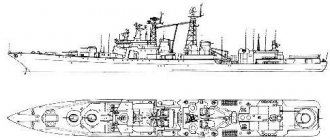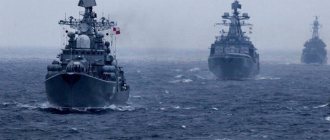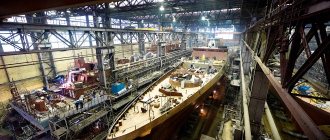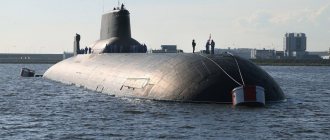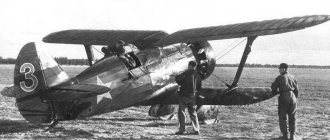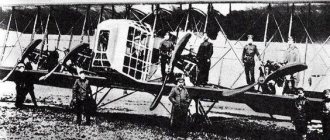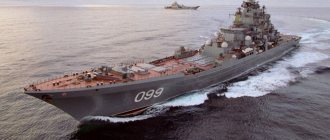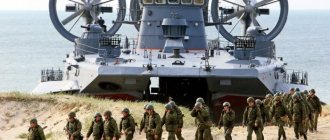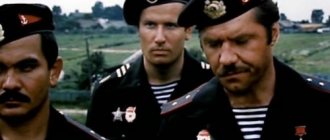On June 1, 1933, the Northern Military Flotilla was formed. Four years later, by order of the People's Commissar of Defense, the flotilla was transformed into the Northern Fleet.
In 2014, a significant part of the military exercises will take place in the waters of the White and Barents Seas. The crews of the ships, in particular, will perform air defense tasks with missile launches from Osa-MA man-portable anti-aircraft missile systems.
On the day of the 81st anniversary, everyone who wants to enlist in the navy will be able to undergo an interview directly during the festive events that will take place at the main base of the Northern Fleet - in the city of Severomorsk.
Parade of ships of the Northern Fleet on May 9, 2010. Photo: Commons.wikimedia.org / Alexey Pavlov
The most important events in the history of the Northern Fleet
The main tasks of the Northern Fleet of the Russian Navy are:
- maintaining the combat readiness of naval nuclear forces;
- protection of economic zones in the territory that is included in the unit’s area of responsibility;
- ensuring safe navigation in the controlled territory;
- foreign policy activities.
The history of this structure dates back to the first day of summer 1933, when the Northern Flotilla was created. Just 4 years later, it was restructured and merged into the Northern Fleet, which continues to operate to this day, replenished with timely equipment.
The newly formed fleet carried out its first “baptism by fire” already in 1940 during the Soviet-Finnish war. The outcome of the Northern Fleet's entry into hostilities was the deprivation of the enemy of expected assistance from the sea.
At the beginning of the Great Patriotic War, the northern division of the navy consisted of 15 submarines, 8 destroyers and 115 combat aircraft. By the end of the war, the amount of military equipment in the Northern Fleet tripled.
Achievements of the fleet during the fighting of 1941-45:
- over 200 units of military naval equipment and ships were destroyed;
- more than 1,200 enemy aircraft were destroyed;
- more than 1,500 convoys were conducted across the Arctic Ocean;
- Tens of thousands of enemy soldiers were exterminated.
But the losses of the fleet during the Great Patriotic War turned out to be quite significant. Just look at the loss of three famous destroyers with the names “Active”, “Crushing”, “Swift” and several dozen submarines.
During World War II, the ships of the “northerners” always took part in escorting and protecting the Allied convoys that went to Murmansk under Lend-Lease
Participation in the war did not go unnoticed, and for its contribution to the victory over the enemy, the Northern Fleet was awarded the Order of the Red Banner.
In the post-war years, the Red Banner Northern Fleet was transformed into a missile-carrying, nuclear and ocean-going fleet.
The beginning of the autumn of 1955 was marked by the launch of a ballistic missile from a submarine. This happened in the White Sea, the events were the first in the world.
Story
Geographically located beyond the Arctic Circle. The basis of the new command was the Northern Fleet[6], withdrawn from the Western Military District. The leadership of the USC Northern Fleet is entrusted to the Commander of the Northern Fleet, Admiral Alexander Moiseev.
In April 2014, the Russian President ordered the creation of a unified system for basing surface ships and submarines of a new generation in the Arctic, strengthening the border, and also establishing a new government body to implement Russia’s policy in this region. In 2014-2015, Spetsstroy of Russia launched the creation of military camps and airfields in six regions of the Arctic - on Alexandra Land (Franz Josef Land archipelago), in the village of Rogachevo on Novaya Zemlya, on Sredny Island (Severnaya Zemlya), on Cape Otto Schmidt, the island Wrangel and Kotelny Island (New Siberian Islands)[7][8][9]. During 2015, it was planned to create a specialized center for training troops in the Arctic. In 2016, the 45th Air Force and Air Defense Army was formed. In total, 13 airfields were built, restored and modernized in the Arctic (including Tiksi, Naryan-Mar, Alykel (Norilsk), Amderma, Anadyr, Rogachevo, Nagurskoye), an aviation training ground and 10 technical positions of radar departments and aviation guidance points[6][ 10].
At the end of October 2014, the military settled a town on Wrangel Island, and a month later - the same block on Cape Schmidt[8]. On May 1, 2015, the Orlan-10 UAV detachment formed in the Chukotka Autonomous Okrug began monitoring the Arctic zone. The UAV crews will perform tasks of objectively monitoring the situation in the Russian Arctic, including the environmental and ice conditions in the near sea zone and along the Northern Sea Route.
Not only units of the Northern Fleet, but also units and units from the Central and Eastern Military Districts are transferred to the new command[2]. Groupings of troops on the island territories of Russia in the Arctic, as well as on Cape Schmidt, were brought together into the Joint Tactical Group, which, back in October 2014, began to ensure Russia’s military security in the Arctic zone. These units are equipped with modern weapons and military equipment, including Rubezh coastal missile systems and Pantsir-S1 anti-aircraft missile and gun systems[6].
The ground component of the command consisted of two Arctic motorized rifle brigades. President Putin signed a decree on the formation of the 80th separate Arctic motorized rifle brigade of the Joint Strategic Command in the village of Alakurtti, Murmansk region, on December 31, 2014. In mid-January 2015, the commander of the Northern Fleet, Admiral Vladimir Korolev, presented her with a battle flag[10].
Organizational composition
Many people are interested in where the Northern Fleet is located. The headquarters is located in Severomorsk, Murmansk region. This city has the status of a closed administrative entity. The Northern Fleet also includes the Belomorsk naval base. located in Severodvinsk, Arkhangelsk region. The Northern Fleet has had two bases since the Great Patriotic War.
Coastal troops
The coastal forces of the Northern Fleet of the Navy are 14 separate structures. One of the largest is the 61st Marine Regiment. It is located on the Kola Peninsula and includes:
- control headquarters;
- two infantry battalions, transport - armored personnel carriers;
- a special air assault battalion, which includes soldiers specially trained for operations on land, at sea, and in the air;
- reconnaissance battalion;
- communications unit;
- anti-aircraft artillery unit;
- a company of sappers and engineers;
- division of protection against radiation and biological and chemical attacks.
It also includes a battalion responsible for logistics.
This Red Banner Regiment includes almost 1,300 personnel and more than 200 units of military equipment.
In addition to the main structures, the coastal troops in 2014 were replenished with a special unit of unmanned aerial vehicles. The aircraft included in the unit perform a reconnaissance function, and, if necessary, can be used to adjust artillery fire.
Naval aviation
The air force is equipped with the latest new generation fighters.
The Ministry of Defense once relied on the naval aviation of the Northern Fleet and was right.
- The fighter aviation regiment has two squadrons of SU-33 and a squadron of SU-25.
- The air base (7050) includes 16 aircraft, 36 military helicopters and 12 Tu-142 anti-submarine aircraft.
- The third group of the airbase, located in Ostafyevo, includes 16 An-24,26 and An-72 aircraft.
Air bases are located in Severomorsk, Kipelovo and Ostafyevo.
Submarine forces
The headquarters of the submarine forces is located in Gadzhievo. The Military Northern Fleet consists of 3 divisions and one detachment.
The path to the Mediterranean lies through the Arctic
This closed village on the Kola Peninsula became known to the whole world after the sinking of the Kursk submarine. 11 years ago, two years after the tragedy, a memorial was erected in memory of all sailors who died in the ocean in the line of duty. The village of Vidyaevo arose just over half a century ago and still exists today as a naval garrison for submariners.
From Murmansk to Vidyaevo is only 46 kilometers. However, this is only on the map. In a straight line. To get here from the Kola capital, you need to drive several hours. The road always winds between picturesque hills. A friend of mine once showed photographs taken in the summer in the vicinity of Vidyaevo to a world-famous photographer.
He unequivocally determined: this is my beloved, beautiful Norway! I supposedly visited these places more than once, I did a photo shoot for a big magazine. When my friend admitted that this was, after all, Russia, the artist became shy and promised to visit there, on the Kola, on the Vidyayevsky hills. From where, in fact, it’s almost the same distance to Norway as it is to Murmansk... A world-famous photographer, when he tried to travel to work in these places, was not allowed there - it’s not allowed, it’s a closed zone. And that's it. If you want beauty, go freely to Norway, it’s nearby!
Based on the name of the river, on the banks of which the first houses were built, the village was given the name Uritsa. Administratively, it became part of the Ura-Gubsky village council of the Kola district of the Murmansk region. And on July 6, 1964, the new village was renamed Vidyaevo in honor of the famous submariner of the Great Patriotic War, Fyodor Vidyayev. As it appears in almost all online directories, the only city-forming object here is... a connection of submarines of the Northern Fleet!
However, the first people appeared here, on the Murmansk coast, back in the Arctic Paleolithic era, three to four thousand years BC. One of their sites was discovered by scientists in the late 40s of the last century, including in the Chan-Ruchya area - just in the vicinity of present-day Vidyaevo! By catching sea animals and fish, the ancient “Vidyayevites” fully provided themselves with food and a tolerable life.
They were replaced by Sami tribes raising reindeer. When the Novgorodians began to develop the Arctic, the Ur lands, rich in mosses, berries, and fish, were granted by Ivan the Terrible to the Pechenga Monastery through the petition of St. Tryphon. This charter was canceled only by Catherine the Second, who designated Uru and Ara Guba as state lands.
The colonization of the Murmansk coast, undertaken by the tsarist government in the second half of the 19th century, did not bypass the place where Vidyaevo is now located. A few kilometers from it in 1864, the largest Finnish settlement in the Russian Arctic appeared - Ura-Guba.
The memorial complex to the sailors who died in the ocean was opened on August 12, 2002, on the anniversary of the sinking of the Kursk nuclear submarine. The complex includes a mass grave for the crew of the K-131 nuclear submarine (Pravda.Ru wrote in detail about that tragedy) and a monument to the Kursk.
Ship composition
The K-560 submarine, during training exercises in 2022, was able to easily hit a target at a distance of 600 km using a cruise missile.
It is worth taking a closer look at the ship's composition of this structure, and there is something to surprise the average person. As part of the Northern Fleet:
- one heavy aircraft-carrying cruiser - the flagship of the fleet;
- three cruisers;
- six large anti-submarine ships;
- one frigate;
- nine warships (small);
- one gun boat;
- nine sea minesweepers;
- five landing ships (large);
- four landing boats.
In total, the Northern Fleet has 38 surface ships and 45 submarines, including 10 nuclear-powered ballistic missile submarines.
The bulk of the ships are produced by the USSR and the Black Sea Shipyard. Most of the ship's crew can boast of impressive age, as these are ships manufactured in the 80s. However, all equipment regularly undergoes preventive maintenance, and all ships and submarines operate successfully.
The latest addition to the fleet was the multi-purpose nuclear submarine Severodvinsk (K-560), which was commissioned in 2014. This is a powerful Russian-made submarine with impressive dimensions - it is more than 115 meters in length. A special feature of the vessel was the unusual arrangement of torpedo tubes behind the central control compartment. The boat's crew is 90 people, its navigation autonomy is up to one hundred days.
Flagship of the Northern Fleet
The flagship of the fleet is the only functioning nuclear-powered missile cruiser “Peter the Great” - the largest ship in the Northern Fleet and the entire Russian Navy. The ship was commissioned in 1988. Its length is 250 meters, and the cruiser's crew consists of 1035 people.
5:04 / 03/07/15 Submarine forces of the Northern Fleet
The Red Banner Submarine Force of the Northern Fleet, transformed on February 10, 2010 from the 11th and 12th squadrons of nuclear submarines, consists of formations of strategic nuclear submarine cruisers armed with ballistic missiles, and various types of multi-purpose missile and torpedo nuclear submarines.
The main base of the submarine forces is Gadzhievo (Murmansk region). Here is the headquarters of the association, a training base, a basing system and logistics support points.
Journalists participating in the press tour were shown two submarines and a submariner training complex. First, I will tell you about the nuclear-powered strategic missile submarine cruiser Project 667BDRM "Karelia"
At the pier, each submarine is guarded by an armed top watchman.
Scuppers
At the entrance to the boat there was a sign on the door:
I apologize for such a small number of photographs, but practically nothing can be photographed inside the nuclear submarine, so I can only bring to your attention some of the equipment and the interior of the living compartments.
Central post
Performance characteristics of ships and aircraft of sworn friends.
This is not a dirty word, but “Boat Volumetric Chemical Protection” designed to extinguish fires.
Shield of emergency equipment. A saw on a metal ship is necessary for sawing wooden stops when sealing possible holes
This is a medical stretcher next to the first aid station.
If an emergency occurs, there are Morse code signs in the compartments in case all communication systems fail.
Residential cabins on a submarine from 2 to 6 places. The video shows an example of a six-seater.
This is a double.
Wardroom campaign. On the right is a portrait of Putin, who went to sea on this submarine in 2000
Submarine layout
It was useless to ask about military campaigns, since the information was strictly confidential, so I inquired about the money issue. The salary of ordinary personnel (let me remind you that there are no conscripts in the submarine fleet) is from 20 to 40 thousand rubles (the right to additional “northern” payments plays an important role), junior officer - from 25 to 45 thousand, senior officer - from 40 to 60 thousand , ship command - from 55 to 70 thousand rubles. Last year, officers were also paid bonuses according to MO order No. 400A, but this year they will not be given; the boat passed the test “unsatisfactorily.” We will have to be content with a less monetary bonus according to the order of the Ministry of Defense No. 1010.
It was the nuclear submarine Karelia.
Since all 30 journalists could not fit on one boat, we were divided into two equal groups. The second party visited the nuclear-powered multi-purpose cruising submarine Project 971 “Panther”.
The report on the Panther will be posted by the operator.
Several photographs of the bay in Gadzhievo.
Strategic nuclear submarine cruiser pr.667BDRM "Tula"
Nuclear multipurpose cruising submarine pr.971 "Vepr"
Road tug pr.737K RB-246
Raid tugs pr.192A RB-109 and pr.737K RB-246
View of the bay.
Video provided by the Northern Fleet Command. It shows the actions of the crew of the nuclear-powered multi-purpose cruising submarine Project 971 "Wolf" and an interview with the commander of the Tiger nuclear submarine, Captain 2nd Rank Pavel Bulgakov, under whose command the crew of the boat won the Navy Commander's Cup "Winner of the competition between ship combat crews for long-term tracking of foreign submarine."
I’m updating yesterday’s entry about the arrival of new submarines to the Northern Fleet. According to the commander of the submarine forces of the Northern Fleet, Rear Admiral Igor Mukhametshin, in 2011 the Northern Fleet will receive three multi-purpose and strategic submarines, including the Borei class.
They also showed us the submariner training complex at the 71st Navy Training Center.
Preparation of self-contained breathing apparatus Ida-M.
Here is an explanatory poster for it.
Submariner's rescue equipment.
Rescue container KAS-150.
All this in action on video.
In this compartment of the UTK they practiced fighting against water, namely sealing a hole.
This is what it looks like in dynamics.
Firefighting was practiced in this compartment.
The nozzles inject diesel fuel and the situation immediately “heats up”.
You can watch the fire in more detail on the video of the Zvezda TV channel (there is also their report on the visit to the nuclear submarine). I flash in the frame.
Tags: Arctic, Northern Fleet, army reports, army, video, weapons, money, interesting things, contract soldiers, medicine, submarines, training, fleet, photo
Commanders
Admiral Nikolai Anatolyevich Evmenov has orders and medals for impeccable service.
The commanders of the Northern Fleet by year are more than 50 people. Command of the Northern Fleet (NSF) of the Russian Federation by year:
- Admiral Gromov N.F. – until 1992;
- Admiral Erofeev O.A - 1992-1999;
- Admiral Popov V.A - 1999-2001;
- Admiral Suchkov G.A. – 2001-20003;
- Vice Admiral S.V. Simonenko – acting 2003-2004;
- Admiral Abramov M.L. – 2004-2005;
- Admiral Vysotsky V.S. – 2005-2007;
- Admiral Maksimov N.M. – 2007-2011;
- Rear Admiral Volozhinsky A.O. – acting in 2011;
- Admiral V.I. Korolev – 2011-2015;
- Admiral N.A. Evmenov – 2015-2019
Today, the command of the Northern Fleet of the Russian Federation is Vice Admiral A.A. Moiseev. Assumed his post in May 2022, awards - Hero of the Russian Federation.
Northern Fleet Day of the Russian Navy
The Day of the Russian Northern Fleet is celebrated annually on June 1, this is the youngest state fleet. On this day and on the day of the Navy, Severomorsk, Murmansk and other cities in which northern military ports are located celebrate their professional holiday on a grand scale. The commanders of the Northern Fleet raise the state flag of Russia and the Navy and lay flowers at the monuments to the sailors. So, in 2013, a monument to officers was unveiled in Severomorsk, where the army corps and unit commanders come annually. The flag of the Northern Fleet looks like this - an emblem of a double-headed eagle with anchors in its claws against the background of the St. Andrew's flag. Many poems and songs have been written dedicated to the cabin boys of the Northern Fleet.
The Russian Northern Fleet constantly conducts large-scale exercises and small-scale exercises involving a small number of weapons. Thanks to this, the necessary skills of behavior in fire conditions are developed. Shipyards are developing the latest modifications of ships with the most modern weapons.
